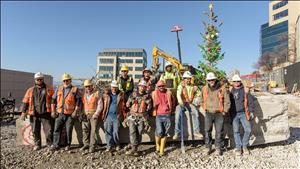On November 21, 2019, demolition work is completed on the decommissioned Alaskan Way Viaduct in Seattle. The final concrete and steel columns at the north end of the viaduct, which have remained in place near the Burlington Northern Santa Fe (BNSF) railroad tracks, are taken down. This work follows the removal of the final remaining horizontal section of the elevated highway at Marion Street two months earlier. With the removal of these sections, the Washington State Department of Transportation (WSDOT) concludes a demolition project that began on February 12, 2019.
Nine Months to Tear Down
First imagined in the 1930s as a traffic bypass route around Seattle's crowded central business district, the Alaskan Way Viaduct took 16 years to build (and about nine months to tear down). The original construction began in February 1950 and was officially completed in 1966 with the opening of an onramp at Columbia Street. The viaduct's central portion, from Pioneer Square to just north of the Pike Place Market at Western Avenue, opened to traffic on April 4, 1953, followed by the christening of the Battery Street Tunnel on July 24, 1954, linking the viaduct to Aurora Avenue and points north on State Route 99. A southern expansion of the viaduct to Spokane Street opened in 1959.
Yet almost as soon as the viaduct was built, critics began examining ways to replace it. The double-decker structure was criticized for its lack of beauty, its adverse effects on the waterfront, and, after it was damanged extensively in the 2001 Nisqually earthquake, its overall safety. The eventual replacement for SR 99 was a deep-bore tunnel, approved by a ballot measure on August 16, 2011. The southern extension to the viaduct was torn down later that year. The new tunnel, beleaguered by construction delays, eventually opened to traffic on February 4, 2019, more than three years behind the original schedule.
With the new tunnel nearly complete, the Alaskan Way Viaduct was permantely closed on February 1, 2019. Kiewit Infrastructure West, the contractor hired by WSDOT, began the process of demolishing the viaduct on February 12.
Trucks, cranes with hydraulic steel jaws, and other heavy equipment were used by Kiewit on the demolition of the concrete and steel-rebar reinforced elevated highway. As the roadway sections came down, the materials were first hauled to Terminal 25 adjacent to the West Seattle Bridge, where they were crushed into small pieces, and then transported back to the north end of the viaduct, where they were used as fill material in the decommissioned Battery Street Tunnel.
By the first week of June, crews were taking down the central section of the viaduct, from the Colman Dock ferry terminal north to the Seattle Aquarium. By September 4, nearly 90 percent of the viaduct had been torn down in an effort WSDOT labeled "a giant recycling project" ("It's Official ...").
One central section -- at Alaskan Way and Marion Street -- did outlast the others. This was due to the need for a pedestrian bridge that allowed walk-on ferry passengers to access the terminal. On September 5, 2019, the old bridge leading to and from Colman Dock was closed and removed; a new pedestrian bridge opened on September 22, connecting to a new ferry terminal. This allowed work crews to tear down the final elevated section of the viaduct, with the last columns coming down September 23. For the first time in more than 60 years, Seattlites had an unobstructed view of Elliott Bay from Pike Place Market to Pioneer Square.
Meanwhile, ramp structures remained at the north and south ends of the viaduct. The last ramp sections over the railway lines at the north end stayed in place for another two months. WSDOT attributed delays to limited work windows, between the hours of 11 p.m. Saturday and 5 a.m. Sunday, given the rail lines were in use at all other times during the week. This work-around was one of many challenges the demolition project faced. "Nothing about this job was easy," Washington State Secretary of Transportation Roger Millar said. "The demolition project was a remarkable accomplishment as the viaduct stood perilously close to buildings and utilities and a critical rail corridor" ("It's Official ...").
Final Pieces Come Down
In early November 2019, Kiewit focused on the removal of the south-end ramp structures above the intersection at S Dearborn Street and First Avenue S. The final north-end columns came down on November 21, heralding the end of the 66-year-old structure. That same week, WSDOT announced that the public could get free pieces of the viaduct as keepsakes, reversing an earlier decision not to allow them. The rocky mementos were free.
The removal of the viaduct allowed WSDOT to proceed with redevelopment of the waterfront along Alaskan Way. New planned features included a 20-acre park and public space, a promenade and bike path, an overlook walk connecting Pike Place Market to the waterfront, and a new seawall.

